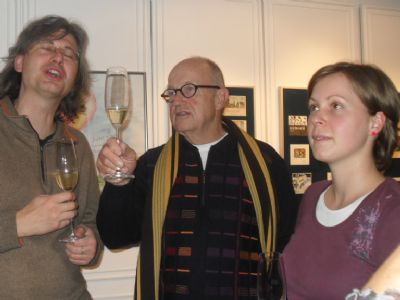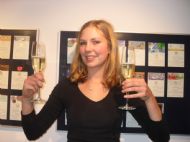

German Wine Culture
Grapes and Culture
(Satis Shroff)
It was a beautiful autumnal day and we, the members of the men´s choir (MGV-Kappel) headed for ZunZingen, a wine-growing area near Müllheim along the country-road in a Winterhalter bus, based in Kirchzarten. We went past Staufen and the Munster Valley hidden by a thick forest in the colours of autumn.
´Oh, that´s the place where we used to go to gather mushrooms,´ quipped Elke Suetterle, a soft spoken, slim lady with long flowing brunette hair.
Yellow mustard fields appeared and in the distance a glorious sunset. An Eurofighter jet streaked with its white jet stream vertically as though it´d found a hole to Heaven in the orange-blue sky.
The bus went slowly along the country-road past picturesque villages with gentle valleys, spurs and hillocks. We saw a Café im Glashaus in Dottingen. There were horses and some mules grazing in small green enclosures. A pretty church with a steep roof and a cross on the top went by with the colourful sunset in the background. Then came the grapevines. There was a Hofladen, a shop attached to the farm, with the farmer´s wife selling self-produced fruits and vegetables. Soon we went past the grey building of the Winzergenossenschaft Laufen. There were carefully planted grape vines, half a metre high on the slopes of where ever you looked. The wood was already cut and neatly stacked for the winter for in the countryside you still use ovens which are fed on wood, and there were huge hay-bundles in sky-blue plastic bags scattered across the fields because everything´s done with agricultural machines.
After the Winzergenossenschaft Britzingen, along the narrow streets you could suddenly see a local artist´s atelier with modern exhibits, and in the distance cypress trees arranged in a row like in the Tosca. Finally we reached Zunzingen, located on a slope. There was a sign with the words ´Gas weg v: Kinder,´ warning car-drivers that there was a Kindergarden ahead.
We were greeted with Badische hospitality by our friend Dirk Schneider and his Mongolian wife and were ushered into the Weinetiketten Museum housed in their spacious home, the first of its kind in Germany. There were 1200 exhibits which keep on changing, and the collection had 120,000 specimens from over Europe, the oldest wine label dating back to 1811.
What was fascinating was the fact that a few wine-labels were specially drawn and painted by renowned artists like Picasso and Chagal and even famous cartoonists.
Dir Schneider, who´sDr. Gustav Schneider´s son, said, ´My parents took over the tradition-rich wine estate in Zunzingen in the year 1995. Since then we´ve been carrying on the success of a marriage between experiencing wine and enjoying it.´ Dr. Gustav Schneider and his wife Elizabeth have two sons: Dirk and Jörg. Whereas Dirk runs the historical wine-castle in Freiburg, which is located between the Jazzhouse and the Goethe Institute, his brother Joerg is responsible for the Walfgasthaus St. Barbara. Dr. Gustav Schneider was an ophthalmologist before he took over the wine-business with his sons.
Zunzingen lies in the middle of the Markgräflerland which is a sunny area, like Ihringen and Freiburg, and the people as well as the grapes enjoy the sun here. To turn the sun-kissed grapes into noble wine lies in the hands of the grape-grower, who combines tradition with modern technology. Zunzingen´s soil is suitable for the vineyards because it is fertile loess earth where the Burgunder grapes and the well-known Markgräfler Gutedel grow.
Dirk mentioned, ´Around 55% of our wines are white wine and 44% are red wine. The best among them belong to the international best. The profile of our wine is: fresh and fruity. We have 90% wines of the dry sort.´
We had the fresh, fruity dry sort to go with dinner and none of us had a headache or a hangover. Good wine.
There are as many labels as there are wines. They tell us also about the time in history, and there are people who gather these wine-labels like postage stamps. You could peruse through the 200 years of wine-history on the thousands of labels from Thomas Wangler´s collection, which were on exhibit arranged according to specific themes. Beside the label of 1811, the ones from Baden are also interesting. You have to be a wine-connoisseur and have time at your disposal.
Wine is the fermented juice of freshly gathered grapes. The character of the wine depends on the species of grapes, the locality of the vineyard and method of cultivation. The main kinds are: sparkling champagne, beverage wines such as the famous red and white wines of Burgundy, Bordeaux, the Rhone Valley and the white wines of the Rhine, Moselle and Loire valleys. A wine can be fortified with the addition of alcohol, as in the case of sherry.
After the sekt-reception at the Weinetikettenmuseum we had an excellent dinner: wine and enjoyment, that´s the enjoyment of culture. When you drink wine you have to sing, as we from the MGV-Kappel did. We sang ´Erhebet gas Glass´ (Raise your glasses), ´Oh, you Maiden From Schwarzwald, How Lovely You Are´ and ´Heaven is a Wonderful Place.´ Zunzingen was an oasis for our senses: wine, cuisine, culture. We boarded the bus and carried out animated conversations till be reached Kappel. A lovely evening, I must say.
 Satis Shroff's CREATIVE WRITING | sitemap | log in
Satis Shroff's CREATIVE WRITING | sitemap | log in



 Satis Shroff's CREATIVE WRITING | sitemap | log in
Satis Shroff's CREATIVE WRITING | sitemap | log in


